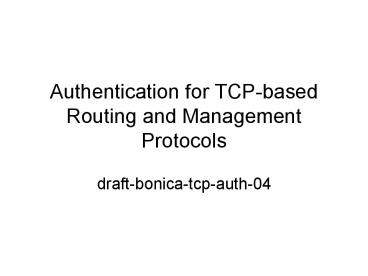Authentication for TCP-based Routing and Management Protocols - PowerPoint PPT Presentation
Title:
Authentication for TCP-based Routing and Management Protocols
Description:
Authentication for TCP-based Routing and Management Protocols. draft ... Draft-weis-tcp-auth-auto-ks. Rejected Approach: In the ... not protect against a ... – PowerPoint PPT presentation
Number of Views:65
Avg rating:3.0/5.0
Title: Authentication for TCP-based Routing and Management Protocols
1
Authentication for TCP-based Routing and
Management Protocols
- draft-bonica-tcp-auth-04
2
Motivation
- Many operators do not authenticate TCP based
routing protocols - BGP, LDP
- Current BCP (RFC 2385) does not fulfill operator
requirement
3
Concerns Regarding RFC 2385
- CPU utilization
- Not addressed in the current memo
- Key management
- Keys need to be refreshed periodically
- Key refresh (typically) requires session reset
- Weak cryptography
- There are many well-know attacks on MD5
4
Alternative Approaches
- Application
- In the Protocols (BGP, LDP, etc.)
- TLS
- Transport
- TCP
- Network
- IKE/IPsec
5
Chosen Approach
- Better TCP-layer authentication
- Enhanced TCP Authentication Option
- Hitless key rollover
- Key chains configured on peer systems
- Key Identifiers
- Stronger cryptography
- CMAC-AES-128-96
- HMAC-SHA-1-89
6
Enhanced Authentication Option
0 1 2
3 0 1 2 3 4 5 6 7 8 9 0 1 2 3 4 5 6
7 8 9 0 1 2 3 4 5 6 7 8 9 0 1 ----------
----------------------
Kind Length TK Alg ID Res
Key ID -------------------
-------------
Authentication Data
//
-------------------
-------------
7
Key Chain
- Contains up to 64 keys
- Each key contains
- Identifier 0..63
- Authentication Algorithm
- Shared secret
- Vector inoutboth
- Start and end time for sending
- Start and end time for receiving
8
Sending System Procedure
- Identify active key candidates
- vector out vector both
- Start-time for sending lt system-time
- End-time for sending gt system time
- If there are no candidates, log event and discard
outbound packet - If there are multiple candidates, select key with
most recent start-time for sending
9
Sending System Procedure (continued)
- Calculate MAC using active key
- Calculate over TCP pseudo-header, TCP header and
TCP payload - By default, include TCP options
- Format Enhanced Authentication Option
- Active key identifier
- Flags
- Message Authentication Code (MAC)
- Authentication Identifier
10
Receiving System Procedure
- Lookup key specified by TCP Option
- Determine whether that key is eligible
- Vector in vector both
- Start-time for receiving lt system time
- End-time for receiving gt end time
- Calculate MAC
- If calculated MAC is equal to received MAC,
accept datagram
11
Authentication Error Procedure
- Discard datagram
- Log
- DO NOT send indication to originator
12
Coming Soon
- Automated session key distribution
- Draft-weis-tcp-auth-auto-ks
13
Rejected Approach In the Protocols
- PROs
- Each routing protocol application takes care of
itself - Although the IDR WG did just deprecate an
earlier BGP attempt because of the TCP RST issue - Independent of network interfaces, just as the
protocols themselves are Independent of network
interfaces - CONs
- Does not protect against a TCP RST attack
- Each routing protocol must be modified in a
similar way
14
Rejected Approach SSL
- PROs
- Protects the protocol at the highest level
without actually modifying the routing protocols - Independent of network interfaces
- CONs
- Does not protect against a TCP RST attack
- TLS can re-establish the connection, but unless
it does it within 90 sec. BGP will tear down the
session.
15
Rejected Approach IKE/IPsec
- PROs
- Protects against a TCP RST attack
- Can be configured to work for directly connected
peers because the IPsec policy can be attached to
a single interface. - CONs
- Policy checking (e.g., access control, QoS,
IPsec) is interface specific on a router. But TCP
applications are interface agnostic! Therefore a
robust solution requires placing IPsec policy on
every possible router interface. This can affects
the performance of all packets directed toward or
routed through the router. - IKE Authentication doesnt provide for a
completely clean roll-over of pre-shared keys,
and certificates are not always appropriate
16
Co-authors and Contributors
- Ron Bonica (Juniper)
- Brian Weis (Cisco)
- Sriram Viswanathan (Cisco)
- Andrew Lange (Alcatel)
- Owen Wheeler (BT)
- Chandrashekhar Appanna (Cisco)
- Andy Heffernan (Juniper)
- Kapil Jain (Juniper)
- David McGrew (Cisco)
- Satish Mynam (mynam_at_cisco.com)
- Anantha Ramaiah (ananth_at_cisco.com)

